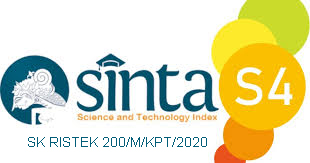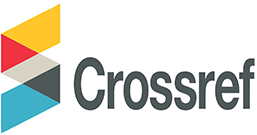Water Quality Monitoring System with Parameter of pH, Temperature, Turbidity, and Salinity Based on Internet of Things
Abstract
This research aims to monitor the quality of water used for aquariums. The physical parameters used are water pH, water temperature, water turbidity, and water salinity. Using a pH sensor, temperature sensor, turbidity sensor, and salinity conductivity sensor with Arduino as the controller. The prototype method used in this research, starting from the formulation, research, building stages to testing and evaluating the results of the research. The working process of the system is when the system is activated, the sensors will detect and capture the amount of value contained in the water, then the data from the sensor is sent to a database in the cloud using an ethernet shield that is connected to the media router as a liaison for the internet network then displayed on the website dashboard in the form of graphs and monitoring record tables in real time. The sensors function to detect water quality, where quality standards have been set in this system, namely temperature standards of 27-30°C, pH standards of 7.0-8.0, turbidity standards of 2.5-5 ntu, and salinity of 20-28 ppt. If the sensor detects non-compliance with water quality standards, the buzzer in this system will sound. From the results of system testing, sensors can detect water quality in real time within 5-10 seconds. Based on the research results, this water quality monitoring system is effective to help ensure the quality of the water in the aquarium so that it always meets the standards.
Keywords
Full Text:
PDFReferences
A. Kusnandar, “Rancang Sistem Monitoring Air Layak Konsumsi Menggunakan Metode Fuzzy Tsukamoto Berbasis Android,” pp. 1–8, 2019.
A. Pebrianto, R. Haryanto, and A. Pratomo, “Diseminasi Sistem Aquaponik Sebagai Salah Satu Solusi Ketahanan Pangan Di Masa Pandemi Covid-19,” PRO Sejah. (Prosiding …, vol. 3, pp. 1–6, 2021.
A. H. Kadafi and U. B. Luhur, “Perancangan pengendalian suhu dan salinitas air pada aquarium ikan botana biru,” vol. 3, no. 1, pp. 62–68.
S. R. Riady, D. Maulana, A. Suwarno, and A. Nugroho, “Implementasi Sistem Monitoring Suhu Pada Produk Makanan di Mesin Sterilisasi Menggunakan Fuzzy Logic Berbasis Internet of Things,” InComTech J. Telekomun. dan Komput., vol. 8, no. 2, pp. 121–132, 2018.
U. Ulumuddin, M. Sudrajat, T. D. Rachmildha, N. Ismail, and E. A. Z. Hamidi, “Prototipe Sistem Monitoring Air Pada Tangki Berbasis Internet of Things Menggunakan Nodemcu Esp8266 Sensor dan Ultrasonik,” Semin. Nas. Tek. Elektro 2017, no. 2016, pp. 100–105, 2017.
E. B. Lewi, U. Sunarya, and D. N. Ramadhan, “Sistem Monitoring Ketinggian Air Berbasis Internet of Things Menggunakan Google Firebase,” Univ. Telkom, D3 Tek. Telekomun., vol. 1, no. 1, pp. 1–8, 2017.
R. K. Putra Asmara, “Rancang Bangun Alat Monitoring Dan Penanganan Kualitas Ait Pada Akuarium Ikan Hias Berbasis Internet Of Things (IOT),” J. Tek. Elektro dan Komput. TRIAC, vol. 7, no. 2, pp. 69–74, 2020.
R. Arifuddin and Y. Sinatra, “Identifikasi Sensor Suhu pada Setup Awal Untuk Pengukuran Suhu Bawah Permukaan,” JEECAE (Journal Electr. Electron. Control. Automot. Eng., vol. 3, no. 2, pp. 209–212, 2018.
M. S. Islam, E. A. Suhendi, S. Si, and M. Si, “RANCANG BANGUN REALTIME MONITORING TINGKAT KEASAMAN ( PH ) DAN KONDUKTIVITAS ELEKTRIK ( EC ) BERBASIS INTERNET OF THINGS ( IOT ) PADA SUNGAI CITARUM DESIGN OF REALTIME MONITORING ACID LEVEL ( PH ) AND ELECTRICAL CONDUCTIVITY ( EC ) BASED ON INTERNET OF THINGS ( IOT ) IN CITARUM RIVER,” vol. 8, no. 2, pp. 1899–1904, 2021.
S. Sukarni et al., “Kontrol Kualitas Air Kolam Ikan Lele Berbasis Microbubbles dan Internet of Things ( IOT),” Pros. Has. Pengabdi. Kpd. Masyakat, no. Hapemas 2, pp. 224–234, 2018.
H. R. Iskandar, D. I. Saputra, and H. Yuliana, “Eksperimental Uji Kekeruhan Air Berbasis Internet of Things Menggunakan Sensor DFRobot SEN0189 dan MQTT Cloud Server,” J. Umj, no. Sigdel 2017, pp. 1–9, 2019.
I. Fauzi, S. Komputer, F. T. Informasi, U. B. Luhur, P. Utara, and K. Lama, “Monitoring Ketinggian dan Suhu Air Dalam Tangki Berbasis Web Menggunakan Arduino Uno & Ethernet Shield,” Bit, vol. 14, no. 1, pp. 39–44, 2017.
A. Meifriyan Pratama, D. Meidelfi, and D. Prayama, “RETRACTED: Monitoring Air Pada Water Torn Berbasis Android dan Mikrokontroller,” JITSI J. Ilm. Teknol. Sist. Inf., vol. 1, no. 3, pp. 97–107, 2020.
Tukadi, W. Widodo, M. Ruswiensari, and A. Qomar, “Monitoring Pemakaian Daya Listrik Secara Realtime Berbasis Internet of Things,” Semin. Nas. Sains dan Teknol. Terap. VII 2019, pp. 581–586, 2018.
M. Faisal, H. Harmadi, and D. Puryanti, “Perancangan Sistem Monitoring Tingkat Kekeruhan Air Secara Realtime Menggunakan Sensor TSD-10,” J. Ilmu Fis. | Univ. Andalas, vol. 8, no. 1, pp. 9–16, 2016.
M. Kautsar, R. R. Isnanto, and E. D. Widianto, “Sistem Monitoring Digital Penggunaan dan Kualitas Kekeruhan Air PDAM Berbasis Mikrokontroler ATMega328 Menggunakan Sensor Aliran Air dan Sensor Fotodiode,” J. Teknol. dan Sist. Komput., vol. 3, no. 1, pp. 79–86, 2015.
J. M. Hudin, D. Susilawati, and M. A. Faisal, “Implementasi Model Agile Pada Monitoring Suhu Kolam Ikan Dengan Algoritma Fuzzy Logic Berbasis Internet of Thing (Iot),” Swabumi, vol. 6, no. 2, pp. 133–138, 2018.
A. I. Irawan, R. Patmasari, and M. R. Hidayat, “Peningkatan Kinerja Sensor DS18B20 pada Sistem IoT Monitoring Suhu Kolam Ikan,” JTERA (Jurnal Teknol. Rekayasa), vol. 5, no. 1, p. 101, 2020.
Y. Rahmanto, A. Rifaini, S. Samsugi, and S. D. Riskiono, “SISTEM MONITORING pH AIR PADA AQUAPONIK MENGGUNAKAN MIKROKONTROLER ARDUINO UNO,” J. Teknol. dan Sist. Tertanam, vol. 1, no. 1, p. 23, 2020.
D. Y. Tadeus, K. Azazi, and D. Ariwibowo, “Model Sistem Monitoring pH dan Kekeruhan pada Akuarium Air Tawar berbasis Internet of Things,” Metana, vol. 15, no. 2, pp. 49–56, 2019.
D. A. Wibisono, S. Aminah, and G. Maulana, “Rancang Bangun Sistem Monitoring Kualitas Air Pada Tambak Udang Berbasis Internet of Things,” Perpust. Univ. Sanata Dharma, no. September, p. viii, 2019.
DOI: https://doi.org/10.31326/jisa.v4i2.965
Refbacks
- There are currently no refbacks.
Copyright (c) 2021 Yazi Adityas, Muchromi Ahmad, Moh Khamim, Khalis Sofi, Sasmitoh Rahmad Riady

This work is licensed under a Creative Commons Attribution-ShareAlike 4.0 International License.
JOURNAL IDENTITY
Journal Name: JISA (Jurnal Informatika dan Sains)
e-ISSN: 2614-8404, p-ISSN: 2776-3234
Publisher: Program Studi Teknik Informatika Universitas Trilogi
Publication Schedule: June and December
Language: English
APC: The Journal Charges Fees for Publishing
Indexing: EBSCO , DOAJ, Google Scholar, Arsip Relawan Jurnal Indonesia, Directory of Research Journals Indexing, Index Copernicus International, PKP Index, Science and Technology Index (SINTA, S4) , Garuda Index
OAI address: http://trilogi.ac.id/journal/ks/index.php/JISA/oai
Contact: jisa@trilogi.ac.id
Sponsored by: DOI – Digital Object Identifier Crossref, Universitas Trilogi
In Collaboration With: Indonesian Artificial Intelligent Ecosystem(IAIE), Relawan Jurnal Indonesia, Jurnal Teknologi dan Sistem Komputer (JTSiskom)
JISA (Jurnal Informatika dan Sains) is Published by Program Studi Teknik Informatika, Universitas Trilogi under Creative Commons Attribution-ShareAlike 4.0 International License.


















